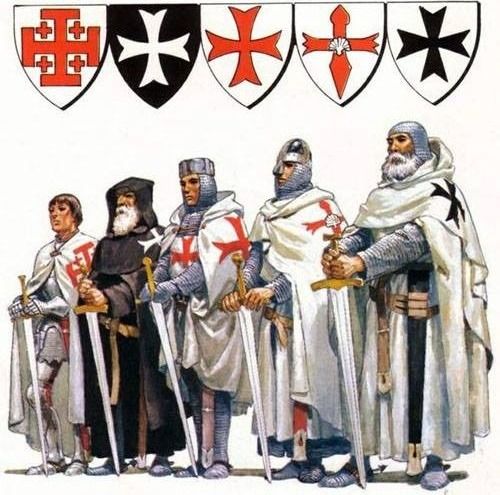10 Medieval Crusader Orders – What Made Each One Unique
Throughout medieval Europe, crusader orders emerged as one of the most fascinating institutions of the Middle Ages. Combining strict religious devotion with military skill, these knightly orders played a critical role in defending pilgrims, waging holy wars, and shaping the politics of their time.In this article, we explore 10 of the most notable crusader orders and what made each one unique.
1. The Knights Templar
Founded: 1115 in Jerusalem
Founders: Hugues de Payens and Godfrey de Saint-AdhemarThe Knights Templar were the first major crusader order, established to protect pilgrims traveling through the Holy Land. Starting with just nine knights, they gained prominence and wealth, establishing a network of fortresses and strongholds across Europe and the Middle East.
The Templars were headquartered at the Temple of Solomon, which gave them their famous name. Their strict code, elite military training, and economic influence set the standard for all future knightly medieval orders.
2. The Hospitallers of St John
Founded: 1070 in Jerusalem
The Hospitallers began as a hospital to care for pilgrims but became a military order in the 1120s. They were unique for dividing their members between fighting knights and brothers focused on religious and healthcare duties, combining military strength with humanitarian service.
Eventually, the Hospitallers established fortresses across the Mediterranean, including their famous stronghold on the island of Malta, leaving a lasting legacy as both warriors and healers.
3. The Knights of St Lazarus
Founded: Shortly after the Hospitallers
The Knights of St Lazarus were primarily composed of lepers. Many knights transferred from the Hospitallers after contracting the disease, and even the lay soldiers were often afflicted.
Despite these limitations, the order fought in the Crusades and provided a model of compassion combined with military duty, making it one of the most unusual crusader orders in history.
4. The Hospitallers of St Thomas of Canterbury
Founded: 1189–1190 during the Siege of Acre
This small English order honored Thomas Becket, the martyred Archbishop of Canterbury. Its membership was limited to English knights, and it never reached the size of larger orders.
It remains a notable example of how national identity influenced the formation of medieval orders.
5. The Teutonic Knights
Founded: 1190 in Acre, recognized by the Pope in 1199
The Teutonic Knights were mainly German crusaders. Unable to gain strongholds in the Holy Land due to the dominance of the Templars and Hospitallers, they shifted their focus to Eastern Europe, waging wars in Prussia, Poland, and Lithuania.
Through military conquest and administration, they became a major political and religious force in the Baltic region, illustrating how crusader orders could adapt to regional needs.
6. The Sword Brethren
Founded: 1201 in Livonia
Also called the Fratres Militiae Christi, the Sword Brethren were created to defend Riga and support Christian expansion in the Baltic. Although initially successful, a major defeat at Siauliai in 1236 led to the order being absorbed into the Teutonic Knights.
Their story demonstrates the volatility and challenges faced by smaller medieval crusader orders.
7. The Knights of Calatrava
Founded: 1157 in Spain
During the Reconquista, the Knights of Calatrava defended territories from Moorish forces. Formed by Cistercian monks and Navarrese soldiers, the order combined monastic discipline with military service, clearing bandits and enemy forces from the region.
This Spanish order exemplified how crusader ideals spread beyond the Holy Land.
8. The Knights of Santiago
Founded: 1150s in Castile, Spain
The Knights of Santiago were unique because they were not monastic. They could marry and own property while protecting pilgrims traveling to Santiago de Compostela. Though smaller than other orders, their influence in the Reconquista was significant.
9. The Order of St James of Altopascio (Order of the Tau)
Founded: Before 952 in Italy, papal recognition in 1239
Arguably the first knightly order, the Order of the Tau combined protection for pilgrims with early military organization. Their hospitals and defense of travelers between Lucca and Genoa demonstrated how crusader orders could integrate humanitarian service with martial duties.
10. The Knights of San Stefano of Tuscany
Founded: 1561 by Grand Duke Cosimo de Medici
A later crusader order, the Knights of San Stefano followed the Benedictine rule and fought corsairs in the Mediterranean. They participated in the Battle of Lepanto (1571), which ended Ottoman naval dominance, highlighting the continued relevance of military religious orders even after the Crusades.
From the Knights Templar to the Knights of San Stefano, medieval crusader orders shaped both the battlefield and society. They combined religious devotion with military service, offering protection to pilgrims, fighting in holy wars, and leaving a lasting impact on European history.
For anyone fascinated by medieval Europe, the study of crusader orders reveals not just the strategy and warfare of the time, but also the complex interplay of faith, politics, and social organization that defined an era.
